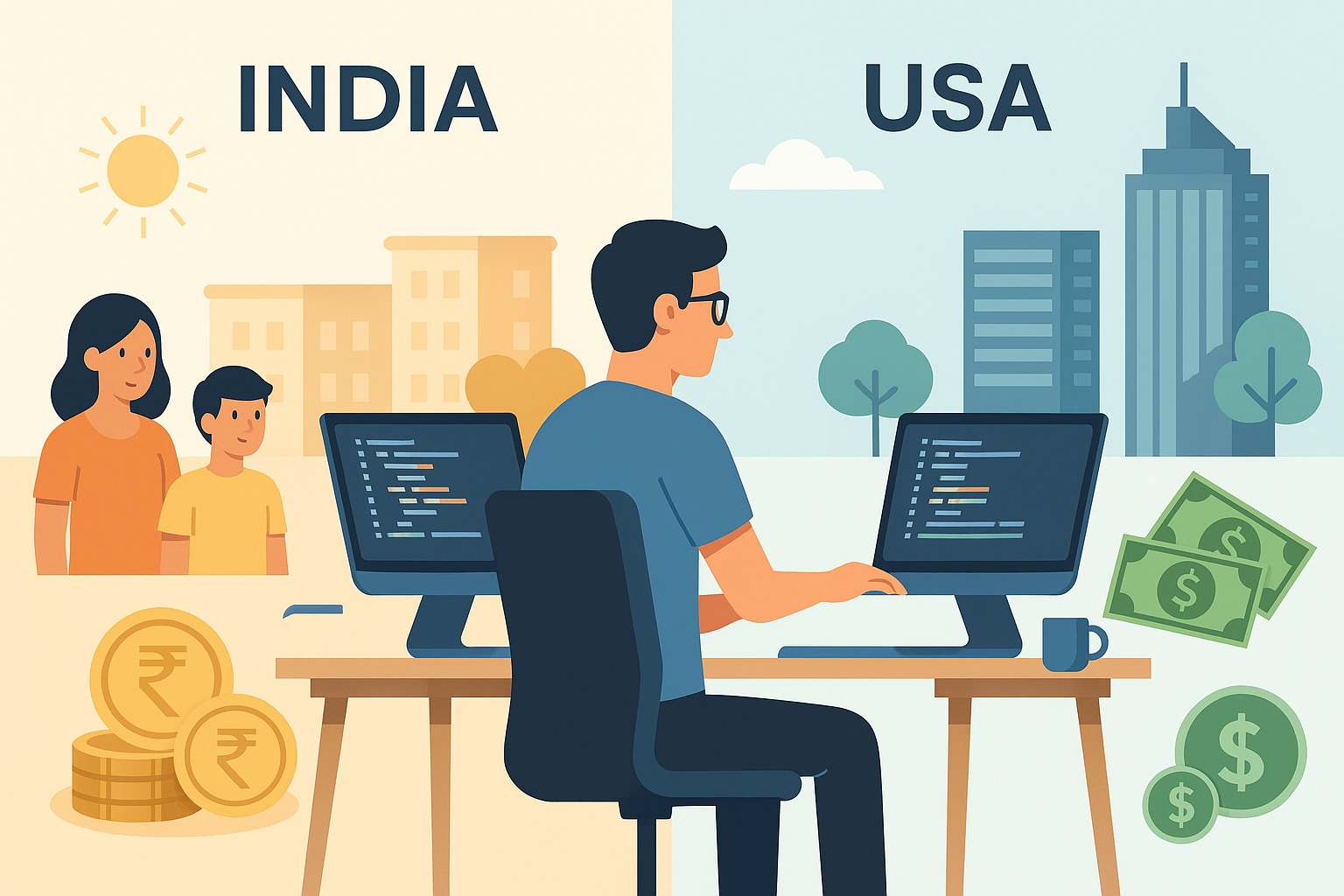In the tech-driven era of 2025, software development remains one of the most sought-after and high-paying careers globally. But one burning question that continues to dominate forums and developer circles is:
“Is it better to work as a software developer in India or the USA?”
While the US has long been seen as the dream destination for tech professionals, India’s rising salaries, thriving startup ecosystem, and growing remote opportunities have changed the game.
Let’s dive deep into a realistic comparison of salaries, savings potential, quality of life, purchasing power, and more—so you can decide where your tech career thrives best.
🧮 Salary Comparison (2025)
🇮🇳 India – Software Developer Salaries
- Entry-Level (0–2 yrs): ₹5 – ₹12 LPA
- Mid-Level (3–6 yrs): ₹15 – ₹30 LPA
- Senior (7–10 yrs+): ₹35 – ₹60+ LPA (up to ₹1 Cr at top MNCs or startups)
- Freelance/Remote from India (US/Global clients): $25–$75/hour = ₹40 – ₹120 LPA+
🔹 Note: Remote developers working for global clients often earn more than local salaries.
🇺🇸 USA – Software Developer Salaries
- Entry-Level (0–2 yrs): $70K – $100K/year
- Mid-Level (3–6 yrs): $110K – $150K/year
- Senior (7–10 yrs+): $160K – $220K+
- FAANG/Top Tech: $250K+ including stock and bonus
🔹 After taxes, actual take-home salary can be 30–35% lower depending on state.
💸 Cost of Living (India vs USA – 2025)
| Category | India (Tier-1 city) | USA (Mid-range city) |
|---|---|---|
| Rent (1BHK) | ₹25,000 – ₹60,000/month | $1,500 – $2,500/month |
| Groceries | ₹4,000 – ₹8,000/month | $300 – $500/month |
| Transportation | ₹2,000 – ₹5,000/month | $100 – $300/month |
| Internet/Mobile | ₹1,000/month | $60 – $100/month |
| Healthcare | Mostly affordable or free | Very expensive (insurance ~$400–$800/month) |
| Education (Kids) | ₹50K–₹1L/year (private) | $10K–$25K/year (private) |
💰 Savings Potential (Monthly Take-home vs Expense)
| Scenario | India (Senior Dev) | USA (Senior Dev) |
|---|---|---|
| Take-home/month (post tax) | ₹3 – ₹4.5L | $8,000 – $10,000 |
| Avg. Expenses | ₹1.2 – ₹1.8L | $4,000 – $5,500 |
| Potential Savings | ₹2L – ₹3L+ | $3,000 – $5,000+ |
💡 In both countries, frugal developers can save well, but India offers better savings %, while the USA offers higher absolute dollar savings.
📊 PPP – Purchasing Power Parity
PPP adjusts income according to cost of living. It shows how far your money goes.
- USA Salary (adjusted PPP in India): A US developer earning $150K can live like a ₹2 Cr/year person in India.
- India Salary (adjusted PPP in USA): A ₹30L salary feels like just $30K–$40K/year in US cities.
🌍 If you earn in dollars and live in India (remote developer), you get the best of both worlds.
🧘♂️ Quality of Life: Lifestyle Breakdown
| Factor | India | USA |
|---|---|---|
| Work-Life Balance | Depends on company (can be hectic) | More standardized + labor protections |
| Travel & Lifestyle | Affordable local travel, rich culture | Global exposure, better infrastructure |
| Healthcare | Inexpensive private care | Excellent care, but very costly |
| Family & Support | Close family ties, domestic help | Independent lifestyle, limited support |
| Safety & Stability | Safe in most areas | Varies by city/state |
| Bureaucracy | Slower systems, red tape | Faster, more digital |
✅ Pros & Cons
🇮🇳 India
Pros:
- Strong family and cultural support
- Lower cost of living
- Increasing remote work opportunities
- Excellent for remote freelancing
- Tax benefits under Indian laws
Cons:
- Infrastructure challenges in some cities
- Less dollar-value savings unless remote
- Fewer legal employee protections
- Office politics and overwork still prevalent
🇺🇸 USA
Pros:
- Global exposure and professional growth
- High absolute income and savings
- Excellent infrastructure and opportunities
- Better work-life balance at most companies
Cons:
- Expensive healthcare and education
- Visa issues (H1B) for immigrants
- Loneliness or lack of social support
- High cost of living in top tech cities
👨💻 Best of Both Worlds? The Remote Work Model
In 2025, more developers are opting to work for US or EU companies remotely from India, earning $80K–$150K+ per year while living locally.
This model offers:
- Global income
- Indian lifestyle
- High savings
- Flexibility
Tools like GitHub, Slack, and Notion have made async work the norm. Developers with strong communication skills, clean Git profiles, and remote experience are thriving in this hybrid model.
🧠 Verdict: Which Is Better?
| Criteria | Best Choice |
|---|---|
| Maximum Savings % | India (especially remote developers) |
| Maximum Dollar Savings | USA (but higher expenses) |
| Work-Life Balance | USA |
| Family Life | India |
| Tech Opportunities | USA (in-person) / Global (remote) |
| Long-Term Retirement | India (lower cost post-career) |
| Career Branding | USA exposure > India jobs |
There’s no one-size-fits-all answer. The better choice depends on your:
- Career goals
- Family priorities
- Willingness to relocate
- Risk appetite
- Preferred work culture
If your goal is to earn well, save smartly, and enjoy balanced living, then remote work for global clients from India in 2025 is becoming the new gold standard.
On the other hand, if you crave global exposure, cutting-edge innovation, and faster career scaling, the USA is still unmatched—provided you’re ready for the higher cost and lifestyle adjustment.
🔄 Pro Tip:
“Earn in dollars, spend in rupees.”
Remote-first careers will define the next decade of developers.







